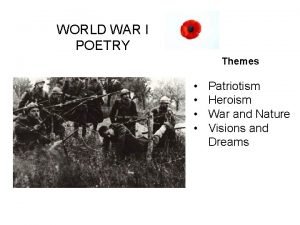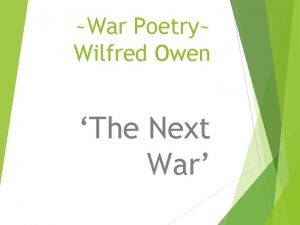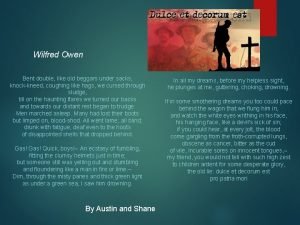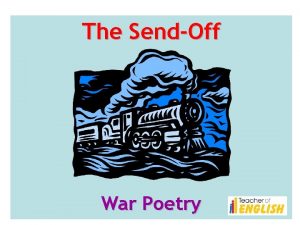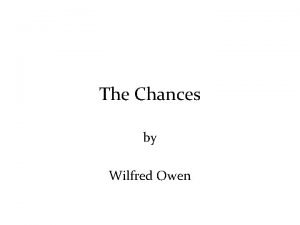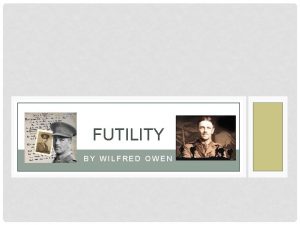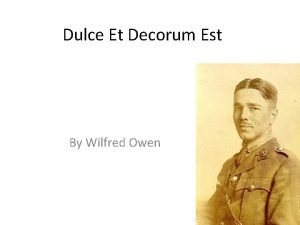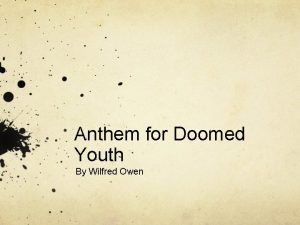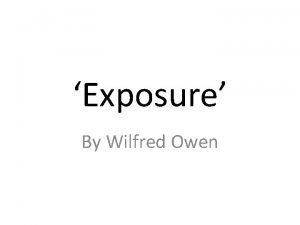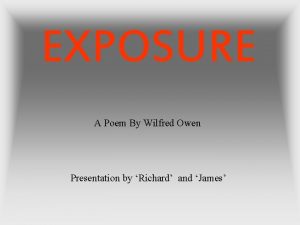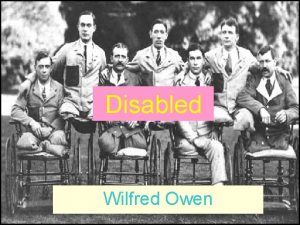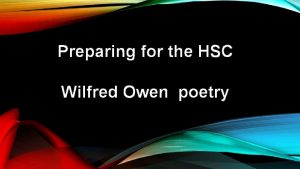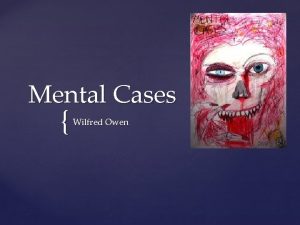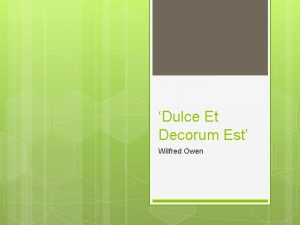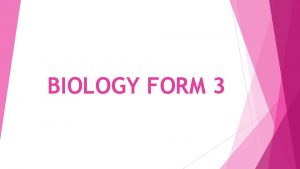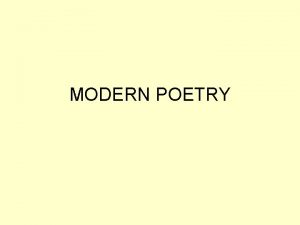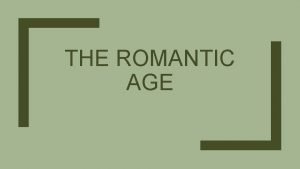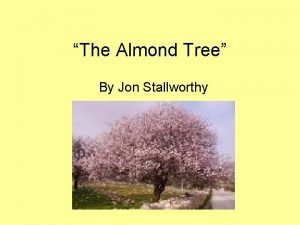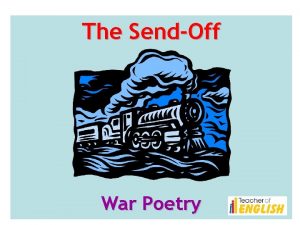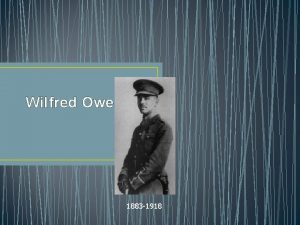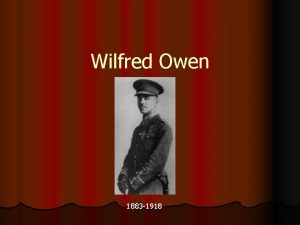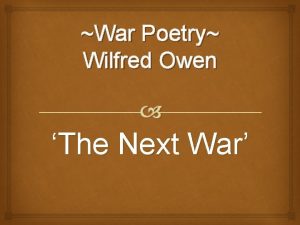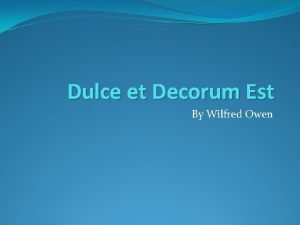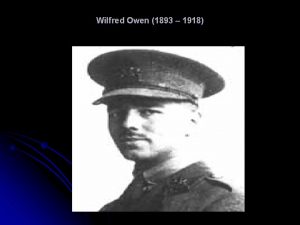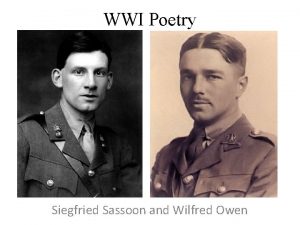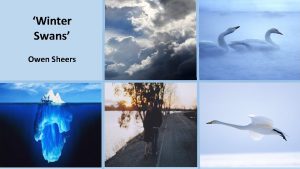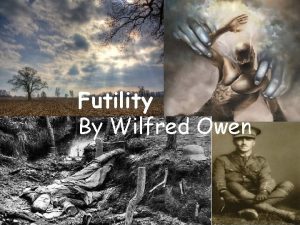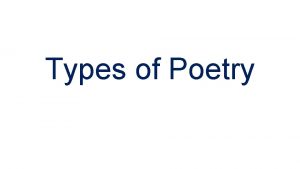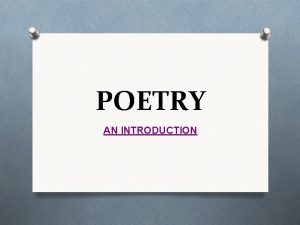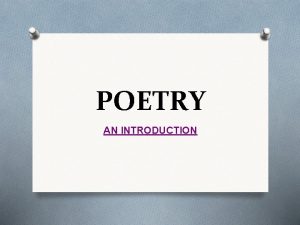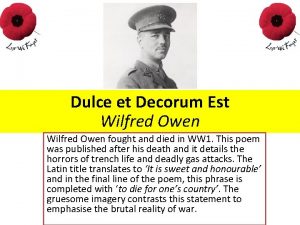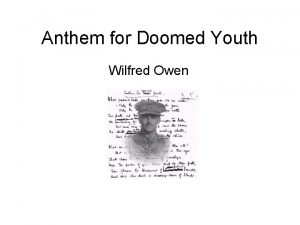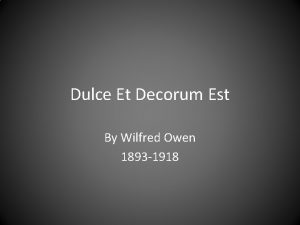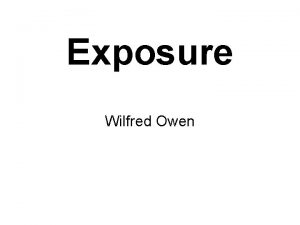The SendOff War Poetry Contents Introduction Wilfred Owen









































- Slides: 41

The Send-Off War Poetry

Contents Introduction Wilfred Owen and the Social Historical Context Lesson 1 What is it about? Lesson 2 Imagery Lesson 3 Style and form Lesson 4 Language Lesson 5 Themes Links A brief biography of Wilfred Owen and an exploration of the poem’s context. Read the poem, discussion of ideas, consolidation of understanding. Discuss the poem’s use of imagery. Analysis of style and form and Owen’s use of poetic devices. Exploration of word choices and depth of meaning, using P. E. E to write about language. Themes of the poem explored, consolidation of the poet’s meaning and purpose Where to find further information about Wilfred Owen and World War One resources

Wilfred Owen

Wilfred Owen Objectives: • To learn about Wilfred Owen and the context of Owen’s poetry

Wilfred Owen Over the coming lessons we will be studying the poem The Send-Off but before we read the poem we need to find out a little bit about the author. Wilfred Owen, a British poet and soldier, was one of the leading poets of World War One. His shocking, realistic war poetry on the horrors of trench life was in stark contrast to both the public perception of war at the time, and to the patriotic verses written by war poets such as Rupert Brooke. Owen was killed in action a week before the war ended. Click the picture to watch a short film about Wilfred Owen

World War One

Historical Context Wilfred Owen is one of the most famous war poets. He was born in 1893 and died in 1918, just one week from the end of World War One. His poetry is characterised by powerful descriptions of the conditions faced by soldiers in the trenches. World War One took place between 1914 and 1918 and is remembered particularly for trench warfare, the use of gas and the appalling and senseless slaughter of millions of men, many as young as 15 years old. Owen’s poems are often violent and realistic, challenging earlier poetry which communicated a pro-war message. The first-hand experience of war is arguably one reason why there is such a shift in the attitude of poets towards war.

World War One Life in the trenches See British troops boarding a train bound for the war Click the images to watch two brief films about the First World War

The Send-Off

An introduction to the poem Objectives: • To read and listen to ‘The Send-Off’ • To discuss ideas/first impressions • To consolidate general understanding of the poem

The Send-Off Down the close, darkening lanes they sang their way To the siding-shed, And lined the train with faces grimly gay. Their breasts were stuck all white with wreath and spray As men's are, dead. Dull porters watched them, and a casual tramp Stood staring hard, Sorry to miss them from the upland camp. Then, unmoved, signals nodded, and a lamp Winked to the guard.

The Send-Off So secretly, like wrongs hushed-up, they went. They were not ours: We never heard to which front these were sent. Nor there if they yet mock what women meant Who gave them flowers. Shall they return to beatings of great bells In wild trainloads? A few, a few, too few for drums and yells, May creep back, silent, to still village wells, Up half-known roads.

What is it about? Read and/or listen to the poem for the first time, what do you think it is about? Click here for a video reading of the poem

What is it about? The poem is made up of eight brief stanzas. Can you work out what is happening in each? Complete the table below: Stanza What is happening Stanzas 1 & Owen describes. . . 2 Stanzas 3 & 4 Stanzas 5 & 6 Stanzas 7 & 8

Consolidate Understanding What are your first impressions of this poem? Below are a few sentence starters to help you write a paragraph about it. 12 th October 11 The Send-Off ‘The Send-Off’ by _____ is about … In the first two stanzas the poet … The third and fourth stanzas describes… Stanzas five and six… In the final two stanzas Owen is saying…

Consolidation In ‘The Send Off’ Owen describes the scene as a group of soldiers are being sent off to war. The men have just come from a sending-off ceremony - cheering crowds, bells, drums, flowers given by strangers – and are now being packed into trains heading for the war. The scene is full of mourning and indignity. The soldiers are waved goodbye by a "dull porter" and a "casual tramp. " Owen hints at the fate of many of the men, "Their chests were stuck all white with wreath and spray, as men's are dead. " Here Owen reminds us that many of these men will not return home. This is reinforced in the line "A few, a few, too few, will return. . . " to "creep back silent. . . up half-known roads. ”

Imagery

Imagery Objectives: • Analyse the imagery used by Wilfred Owen in ‘The Send-Off’

Imagery Look at the imagery used by Owen in this poem. What words and phrases are used to describe the scene at the train station? How does Owen create a sinister mood at the start of the poem? What do you think has happened to the cheering crowds? How might the men be feeling now they are on the train? What words are used to suggest silence and secrecy? What images remind you of a funeral?

Imagery Look at the imagery used in the first four stanzas. Why does the poet use these particular images? The Images Down the close, darkening lanes they sang their way To the siding-shed faces grimly gay Their breasts were stuck all white with wreath and spray As men's are, dead Dull porters watched them, and a casual tramp Stood staring hard unmoved, signals nodded, and a lamp Winked to the guard. What the image conveys

Imagery Look at the imagery used in the final four stanzas. Why does the poet use these particular images? The Images So secretly, like wrongs hushed-up, they went We never heard to which front these were sent Shall they return to beatings of great bells In wild trainloads? A few, a few, too few for drums and yells creep back, silent, to still village wells, Up half-known roads What the image conveys

‘Wrongs hushedup’ From the beginning, the atmosphere seems menacing. The lanes are ‘darkening’ and claustrophobic and the siding shed reminds us of a slaughterhouse. Send-Off celebrations are over, the crowds have dispersed and the soldiers are watched only by 'dull' porters and a tramp. The flowers given to the men have a double meaning as white flowers are associated with death. The departure of the soldiers appears secretive, ‘like wrongs hushed-up’. Owen suggests that this is because the true nature of what is happening to them is being hidden.

Style and Structure

Poetic devices & structure Objectives: • Analyse the use of poetic devices and structure in ‘The Send-Off’

Structure The poem has an unusual structure: a three line stanza followed by a two line stanza, linked together by rhyme. The stanzas are made up of long and short lines, the short line creating a mood of bitterness and quiet anger. Symbols of death are repeated through out the stanzas, ‘bells’, white ‘flowers’ and the ‘wreath’ all point the reader to the fate that awaits thousands of such men.

Structure The poem also has a number of contradictions and ambiguities. The oxymoron ‘grimly gay’ in the men's expressions emphasises the uncertainty of their departure and possibly the realisation of the destiny which awaits them. The poem is set at dusk and the darkness acts as a metaphor for the dark future that lays ahead. An atmosphere of conspiracy exists throughout the poem but is emphasised in stanza four. The signal ‘nods’, the lamp ‘winks’ to the guard and the men are silently taken away by the train into the night.

Poetic Techniques Match the technique with the correct definition. Technique personification Definition the act or process of saying or writing something again simile the attribution of human qualities to objects alliteration a comparison between two different things, especially a phrase containing the word 'like' or 'as’ repetition the use of the same letter or sound at the beginning of words in a sentence

Poetic Techniques Match the technique with the correct definition. Technique personification Definition the act or process of saying or writing something again simile the attribution of human qualities to objects alliteration a comparison between two different things, especially a phrase containing the word 'like' or 'as’ repetition the use of the same letter or sound at the beginning of words in a sentence

Poetic Techniques Think about the poetic techniques discussed on the last slide. Copy down the table below. Find examples in the poem and write down the effect created. Technique Evidence personification ‘unmoved, signals nodded, and a lamp Winked to the guard’ alliteration ‘white with wreath’ simile repetition Effect

Poetic Devices How does Owen use structure and poetic devices to describe the scene as the soldiers board the trains and leave for the war? Use the sentence starters below to help you write a paragraph about it. 12 th June 11 The Send-Off In ‘The Send-Off’ Wilfred Owen uses a number of poetic devices… The simile… Personification such as…… Alliteration is used to. .

Writing about poetry using P. E. E

Writing about poetry and P. E. E Objectives: • To understand how to use P. E. E when writing about poetry

Writing about the poem You should always, when writing about any text, use the P. E. E formula. Make a point, find some evidence and then explain the evidence in detail.

Point, Evidence, Explain Look at how Owen uses language in the poem. Make three good points about the poem, select three quotations to back up your points then explain the quotations in detail. Point The poem begins with an ominous and foreboding mood. Evidence Explain ‘Down the close, darkening lanes they sang their way To the siding-shed, And lined the train with faces grimly gay. ’ Owen uses language here to create a feeling of fear and impending doom. The ‘close, darkening lanes’ are claustrophobic and frightening and the send-off is clouded in darkness as the men bid farewell to home and head into the unknown.

Don’t forget to explain yourself Use the information from the table to write three points about how Owen uses language, structure and devices in the poem. Add a quote and explanation for each point. For example The poem describes… In the first stanza the poet… This conveys. . .

Plenary Read your paragraph about ‘The Send-Off’ to the rest of the group. Ask your peers how it could be improved.

Themes and Links

Themes and links Objectives: • To explore themes of the poem • Consolidate knowledge and understanding of the poet’s meaning and purpose

Themes This is an anti-war poem. The opening stanza reveals that this is not an occasion of celebration and happiness but one of fear and shame. By the time the train leaves for the front the cheering crowds have gone and only a porter and a tramp are there to watch the men go. The soldiers try to be cheerful by singing and smiling but their happiness seems forced and false hiding their fear. Owen presents the soldiers as naive and innocent victims. Like lambs to the slaughter they head off to war unaware that only a very few will ever return.

Links

Links Annotated copy of the poem The Wilfred Owen Website The War Poetry website Audio reading of the poem by Kenneth Branagh World War One resources
 Poem on online teaching
Poem on online teaching Dulce et decorum est structure
Dulce et decorum est structure Bent double like
Bent double like The send off by wilfred owen
The send off by wilfred owen The chances wilfred owen
The chances wilfred owen What is futility by wilfred owen about
What is futility by wilfred owen about Exposure wilfred owen
Exposure wilfred owen Dulce et decorum est rhyme scheme
Dulce et decorum est rhyme scheme Anthem for doomed youth analysis
Anthem for doomed youth analysis Winter spring god of war
Winter spring god of war Exposure wilfred owen summary
Exposure wilfred owen summary Wilfred owen disabled
Wilfred owen disabled Wilfred owen poems hsc
Wilfred owen poems hsc Mental cases wilfred owen
Mental cases wilfred owen Dulce et decorum est structure
Dulce et decorum est structure Context of dulce et decorum est
Context of dulce et decorum est Contents introduction
Contents introduction Wilfred
Wilfred War at home vs war abroad madison
War at home vs war abroad madison Vietnam war
Vietnam war Lesson 1 the origins of the cold war
Lesson 1 the origins of the cold war Truman doctrine and marshall plan venn diagram
Truman doctrine and marshall plan venn diagram Why was josette dugas for the war of 1812
Why was josette dugas for the war of 1812 Ich war du
Ich war du Study jams force and motion
Study jams force and motion Why was the civil war the first modern war
Why was the civil war the first modern war Already simple past
Already simple past Chapter 16 lesson 2 challenges to slavery
Chapter 16 lesson 2 challenges to slavery Cold war proxy
Cold war proxy Chapter 30 the war to end war
Chapter 30 the war to end war Chapter 30 the war to end war
Chapter 30 the war to end war Poem about romantic period
Poem about romantic period Experimentation in modern poetry
Experimentation in modern poetry Narrative vs lyric poetry
Narrative vs lyric poetry Augustan poetry aim
Augustan poetry aim Almond tree poem
Almond tree poem Hình ảnh bộ gõ cơ thể búng tay
Hình ảnh bộ gõ cơ thể búng tay Slidetodoc
Slidetodoc Bổ thể
Bổ thể Tỉ lệ cơ thể trẻ em
Tỉ lệ cơ thể trẻ em Gấu đi như thế nào
Gấu đi như thế nào Tư thế worm breton
Tư thế worm breton
